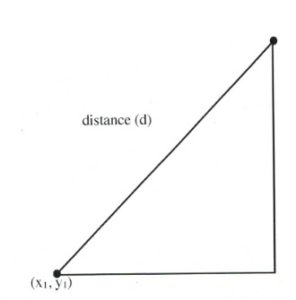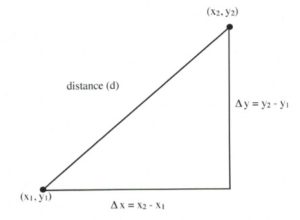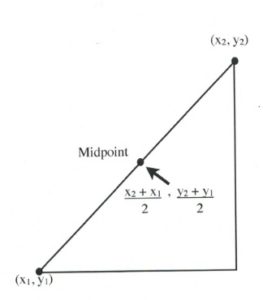Chapter 3: Graphing
3.2 Midpoint and Distance Between Points
Finding the Distance Between Two Points
The logic used to find the distance between two data points on a graph involves the construction of a right triangle using the two data points and the Pythagorean theorem ![]() to find the distance.
to find the distance.
To do this for the two data points ![]() and
and ![]() , the distance between these two points
, the distance between these two points ![]() will be found using
will be found using ![]() and
and ![]()
Using the Pythagorean theorem, this will end up looking like:
![]()

or, in expanded form:
![]()

On graph paper, this looks like the following. For this illustration, both ![]() and
and ![]() are 7 units long, making the distance
are 7 units long, making the distance ![]() or
or ![]() .
.

The square root of 98 is approximately 9.899 units long.
Example 3.2.1
Find the distance between the points ![]() and
and ![]() .
.
Start by identifying which are the two data points ![]() and
and ![]() . Let
. Let ![]() be
be ![]() and
and ![]() be
be ![]() .
.
Now:
![]() or
or ![]() and
and ![]() or
or ![]() .
.
This means that
![]()
or
![]()
which reduces to
![]()
or
![]()
Taking the square root, the result is ![]() .
.
Finding the Midway Between Two Points (Midpoint)
The logic used to find the midpoint between two data points ![]() and
and ![]() on a graph involves finding the average values of the
on a graph involves finding the average values of the ![]() data points
data points ![]() and the of the
and the of the ![]() data points
data points ![]() . The averages are found by adding both data points together and dividing them by
. The averages are found by adding both data points together and dividing them by ![]() .
.
In an equation, this looks like:
![]() and
and ![]()
Example 3.2.2
Find the midpoint between the points ![]() and
and ![]() .
.

We start by adding the two ![]() data points
data points ![]() and then dividing this result by 2.
and then dividing this result by 2.
![]()
or
![]()
The midpoint’s ![]() -coordinate is found by adding the two
-coordinate is found by adding the two ![]() data points
data points ![]() and then dividing this result by 2.
and then dividing this result by 2.
![]()
or
![]()
The midpoint between the points ![]() and
and ![]() is at the data point
is at the data point ![]() .
.
Questions
For questions 1 to 8, find the distance between the points.
- (−6, −1) and (6, 4)
- (1, −4) and (5, −1)
- (−5, −1) and (3, 5)
- (6, −4) and (12, 4)
- (−8, −2) and (4, 3)
- (3, −2) and (7, 1)
- (−10, −6) and (−2, 0)
- (8, −2) and (14, 6)
For questions 9 to 16, find the midpoint between the points.
- (−6, −1) and (6, 5)
- (1, −4) and (5, −2)
- (−5, −1) and (3, 5)
- (6, −4) and (12, 4)
- (−8, −1) and (6, 7)
- (1, −6) and (3, −2)
- (−7, −1) and (3, 9)
- (2, −2) and (12, 4)

